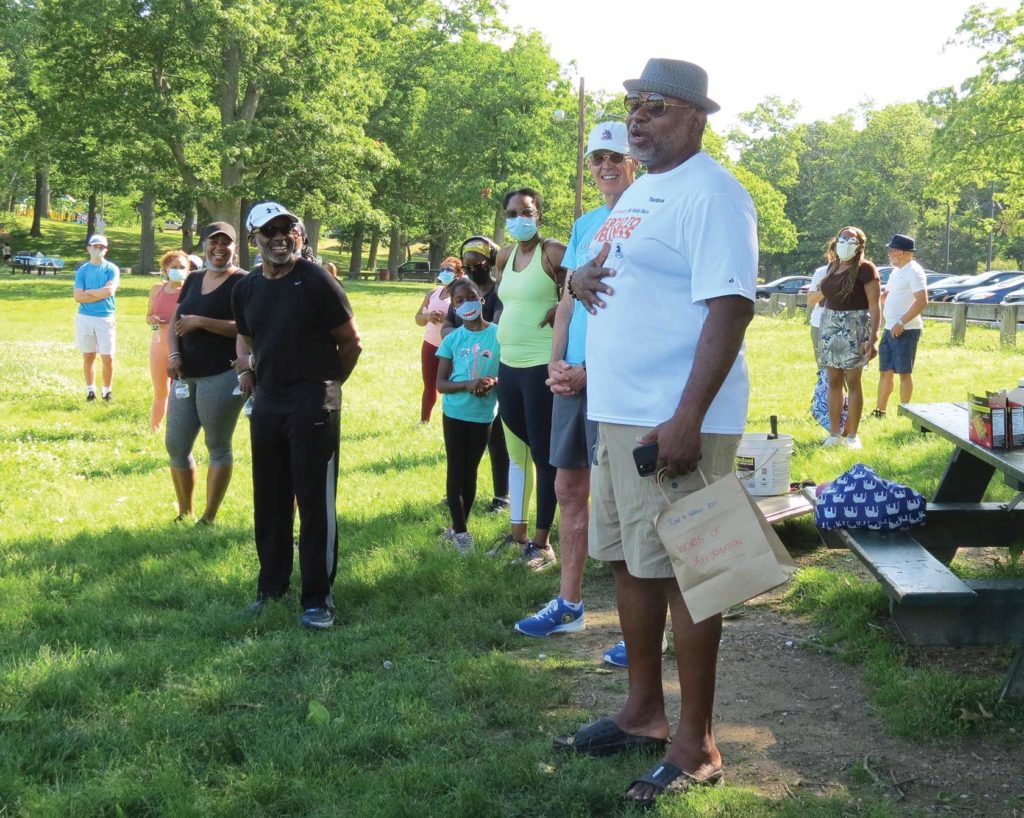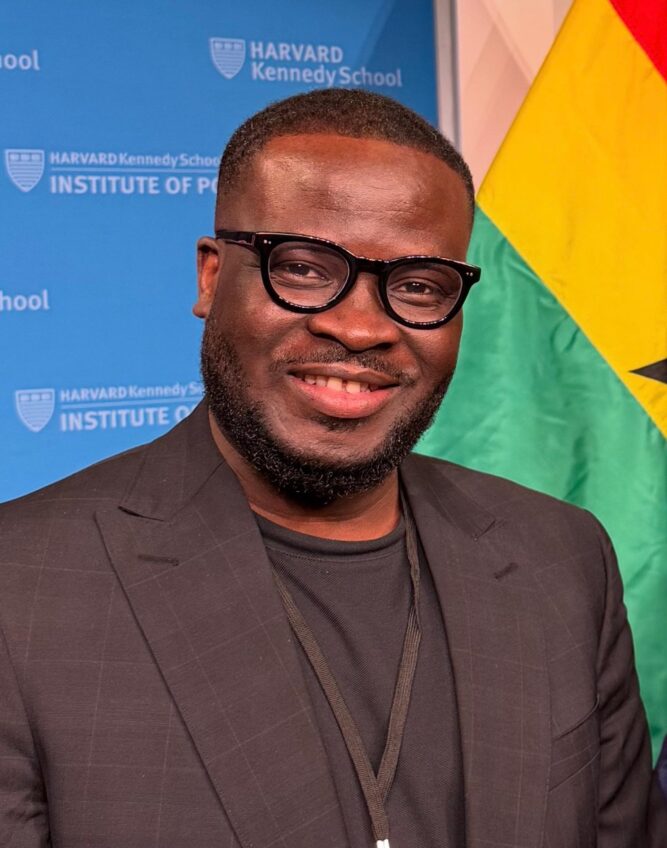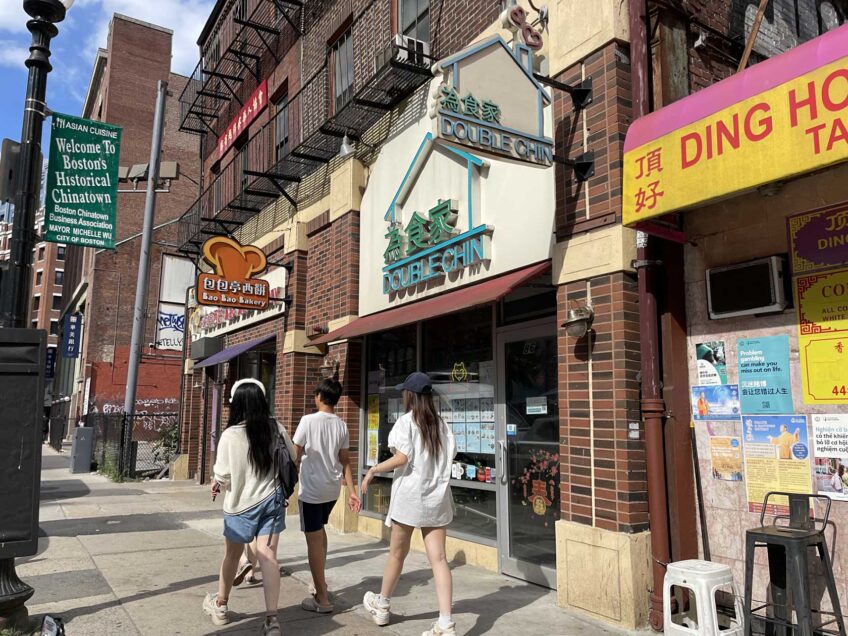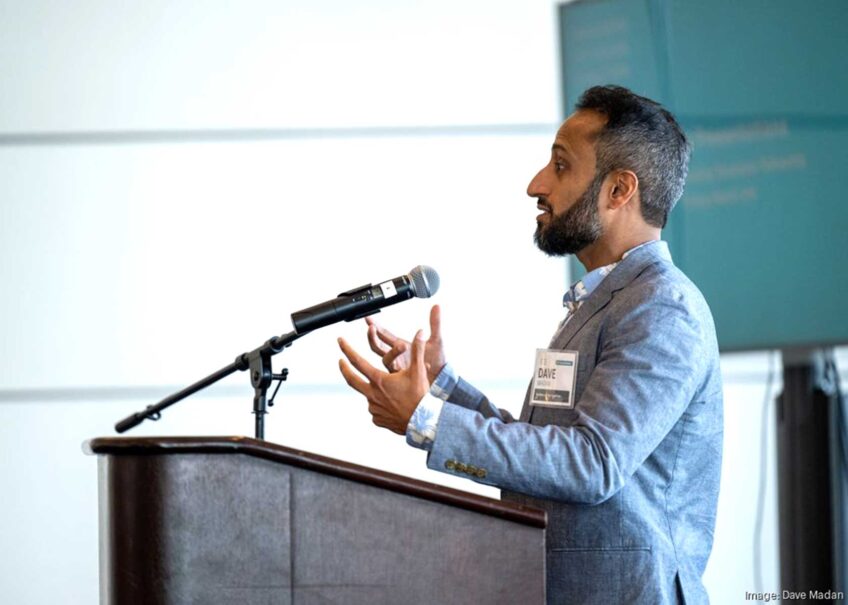COVID casts a light on health disparities
Activists work to build resilience before the next pandemic hits

It took a personal health scare to get Thaddeus Miles into running.
His longtime job as director of safety for MassHousing brought plenty of stress. One day in 2010, after attending a funeral, Miles headed to the gym. While bench pressing, he suddenly felt he was about to pass out. When the EMTs arrived, his blood pressure was 220/180; at the hospital he learned he had an enlarged heart.
“I started looking at my weight and all the other factors that lend themselves to health issues. I have a family history of diabetes and high blood pressure,” he said. “I wondered, ‘What can I do?’”
Realizing he needed aerobic exercise for heart health and weight loss, Miles took up walking, then running.

Dimock Center CEO Dr. Charles Anderson (r) was one of 700 participants in the Road to Wellness event in September. COURTESY PHOTO
When he was ready to try a 5k race, he was dismayed to find none in Roxbury, the traditionally Black neighborhood in Boston’s geographic center. Through HoodFit, the fitness movement he launched in 2014, Miles organized a community run/walk event. That led to partnering with Boston Athletic Association and Roxbury’s Dimock Community Health Center to create the annual Road to Wellness 5k Run/Walk. Now in its seventh year, this fall the event drew 700 people to run a 3.1-mile route or walk a two-mile loop through Roxbury.
COVID-19 has given Miles another wake-up call. At least 10 extended family members have died from the virus. “All of us have several comorbidities,” he said, referring to the underlying health conditions that can make COVID far more deadly.
He continues to be a community health influencer, sharing his reasons for getting vaccinated in videos on his BlackJoy blog and in Dimock’s “Vaccine Street Team” initiative and inspiring others to do so.
A virus with disparate impact
As the pandemic emerged in 2020, it quickly became clear that vulnerability to the virus’ worst effects was higher in some groups than others, including older people and those with certain underlying health conditions such as obesity, lung diseases, and the diseases that run in Miles’ family — hypertension and diabetes. In fact, many of COVID’s high-risk health conditions are more prevalent among African Americans and Latinos.
Nationwide, Black people who catch COVID are nearly three times more likely to be hospitalized and twice as likely to die as white people, according to the Centers for Disease Control and Prevention. Here in Boston, Black people have accounted for 25% of known cases — roughly matching their proportion of the city’s population — but an alarming 33% of the city’s 1,456 deaths as of early November, according to Boston Public Health Commission (BPHC).
The unequal death toll and chronic health condition revelations may have startled the general public and even policymakers — but to those immersed in community health, it was old news.
For Michael Curry, executive director of the Massachusetts League of Community Health Centers, former president of the NAACP Boston Branch and a co-chair of Massachusetts’ COVID Health Equity Task Force, the virus’ disparate impact is another page of a too-familiar story.
“This COVID epiphany that everyone had around inequities — we knew this already,” Curry said. “Our community health center patients are almost certainly dealing with higher rates of diabetes, heart disease, cancer, almost every disease we can name, and living shorter lives. We’re used to losing uncles, aunts, grandparents, cousins at higher rates at a young age.”
Dr. Stephen Wilson, chair of family medicine at Boston Medical Center, the city’s safety-net hospital, said, “It’s not a particular surprise that more Black patients would die. But because of the sheer numbers, outside the BMC community it really slapped people in the face.”
With the pandemic shining such a glaring light on the vulnerability of people living with chronic diseases, what will change? What can be done to build resilience in advance of a future epidemic?
The Banner spoke with local community and health leaders about whether COVID will be a wake-up call to improve health, and what’s being done now — even while working to turn the heavy ship of longstanding inequities — to reduce the prevalence of chronic diseases in Black communities.
Not surprisingly, it’s complicated.
Chronic conditions increase other risks
A March 2021 report from the World Obesity Federation states in stark terms that increased body weight is the second greatest predictor of hospitalization and death in COVID-19 patients. Only old age is a higher risk. In addition, the authors warn, “A number of other respiratory viruses lead to more severe consequences in people living with excess bodyweight, giving good reasons to expect the next pandemic to have similar effects.”
BMC’s Wilson said, “If you have to be intubated, having obesity presents a higher risk for ventilation problems. And obesity itself is a marker for a general state of health. The higher your body mass index (BMI), the more you are at risk for a number of illnesses — diabetes, high blood pressure, stroke.”
And diabetes, when not managed properly, makes infections more severe, Dimock Center CEO Dr. Charles Anderson explained.
“There’s an association between high blood sugar and decreased immune function,” he said. “It’s a complex system, but the fact is that with chronically high blood sugar, there’s a chronic blunting of the immune system. It leads to a lot of complications. It impacts us significantly.”
Health disparities are linked to external factors
Health equity and racial justice advocates have long noted that racial health disparities stem in large part from social determinants of health — those outside factors such as food insecurity, housing instability and insufficient access to health care that influence health and disproportionately affect poorer communities and racial minority groups.
Mattapan Food and Fitness Coalition (MFFC) is a nonprofit focusing on increasing access to healthy food and exercise opportunities to address obesity and other chronic health conditions in Mattapan, a Boston neighborhood whose population is more than 75% Black and has a large number of immigrants. Mattapan has some of the highest rates of diabetes, hypertension and obesity in the city, according to BPHC health data maps.
“We’ve known for a long time about the high rates of diabetes, cardiovascular disease, a number of conditions historically related to obesity,” said MFFC founder Vivien Morris, a registered dietician. Healthy eating is easier said than done, though, she noted, when an apple costs more than a bag of chips or when fresh fruit isn’t even sold nearby.
BPHC Executive Director Bisola Ojikutu spelled out the problem in similar terms.
“We know there’s a higher mortality rate from COVID-19 associated with a number of different illnesses,” she said. “The pandemic just amplifies the fact that people don’t have equitable access to care, that we haven’t provided the right resources for prevention.”
She added, “Prevention is critical — and this brings me back to the social determinants of health. As we talk about healthy eating and active lifestyle, we have to look at what is your neighborhood environment, your built environment? What about residential segregation, and access to quality foods, and access to parks, and access to a place where you can exercise?”
While doctors can counsel individual patients, and leaders like Miles and Morris work to advance community-level health, significant progress is difficult in the face of so many longstanding structural inequities.
“You can’t chip away at the diabetes in person X,” Ojikutu said, “without dealing with community Y that’s experiencing the stress and debilitation of structural racism.”
Then there’s the often-deep distrust of health care and government systems in historically marginalized communities. Miles’ own distrust made him hesitant at first to get the vaccine. Ojikutu sees the burden falling on the institutions to make themselves more trustworthy rather than simply trying to urge trust. “It’s a two-way street,” she said.
What’s more, on top of the pre-existing health and societal conditions, enduring the pandemic has made many people even less healthy. With doctor’s and dentist’s offices closed or limiting visits, primary health care took a hit. Morris notes that some of the people she talks with about food and fitness need to redouble their efforts now because they gained weight staying in during the pandemic.
Stigma is an obstacle
Chronic conditions clearly are endangering people, but it’s not easy to talk about weight and obesity — having BMI at or above 30 — without seeming to judge or “blame the victim.”
Calculated as weight in kilograms divided by height squared, BMI isn’t exactly equivalent to fatness — an athlete might have less fat than a non-athlete with the same BMI — but it’s a good general indication of weight status.
“It’s not about how you look,” Wilson emphasized. “BMI is just a number that’s connected with poorer health outcomes.”
He added, “Individuals have to make decisions about health. But if we say it’s all the individual’s fault, that’s a mistake. So much is in a context of what you’re brought up with, what [food and exercise options] are available in your neighborhood.”
Community and individual health actions
At the community level, programs like farmers markets and run/walk events that gather many people for healthy activity can make a difference, even if not formally measuring before-and-after health. To increase the impact of Road to Wellness, coaches hold trainings for months beforehand to help people get in shape and overcome fears that it’s not possible.
“It’s good for people to say, ‘This is something I can do for myself, something I can control.’ It can be incredibly therapeutic,” Dimock Center’s Anderson said.
Miles said, “You’d be surprised at how many people of color, at every training and every race, tell me, ‘You starting this race saved my life.’”
The most effective health messages come from trusted peers and community members, many say.
“You can imagine, with the Street Team videos, how many people showed up to get their vaccine because they knew Thaddeus Miles did it,” Anderson said. “Thaddeus and others like Reverend [Ray] Hammonds saying it was much more powerful than Dr. Anderson saying it. So now we’re talking about how we can use this approach with things like diabetes and hypertension.”
Ojikutu agrees. “You can’t have thinner people come in and say, ‘Oh, well, you’ve got to be thin,’ or people who are not people of color and overweight. It has to be people who identify with these groups and are experiencing the same problems leading the way.”
Miles found that COVID opened a door to have deeper health conversations with family and friends. With that opening, he’s been influencing others, particularly other Black men, to take charge of their health. “If you’re a Black man,” he observed, “you don’t always go to the doctor, you don’t get those regular check-ups.”
Chronic condition monitoring and support
“We know that Black individuals are more likely than white individuals to use an emergency department as a usual source of care,” said Ojikutu. “But primary care providers are the ones who screen you for all of these things. They notice you’re overweight before you become obese.”
BMC’s Family Medicine Department this fall launched an overweight and obesity support group run by Medical Director Keri Sewell, who is certified in obesity medicine. It’s the beginning of a series of interventions to help patients live healthier lifestyles, Wilson said.
At Mattapan Community Health Center, Medical Director Aimee Williams and CEO Guale Valdez noted that as the pandemic interrupted primary care, having patients miss regular blood pressure checks was particularly concerning, given that 30% of the Mattapan center’s patients have hypertension.
Now, a COVID-19 Telehealth Program grant from the FCC is enabling them to supply at-home blood pressure monitoring equipment to all of their patients with hypertension. Using Bluetooth technology, the monitors convey the results to the health center in real-time, offering an opportunity to improve management of this chronic condition.
“Instead of getting one blood pressure reading a month, now we can get a reading every single day. We can start looking at trends, we can adjust medications,” said Williams.
Institutional actions and funding
Tackling health disparities on a larger scale requires policies, action and investment of funds at the institutional and government levels.
Wilson said he would like to see a shift in how incentives work in the health care system, where reimbursement would be based on increasing population health metrics, not simply on payments per visit.
Ojikutu envisions a multi-faceted, multi-level, cross-sector approach, requiring “political will, programming support, sustainability and capacity-building.”
When Ojikutu took the helm at BPHC this year, she found that BPHC had in the past launched several promising programs for chronic disease prevention, but some have languished as federal grant funding dried up during the Trump years. Now she hopes that under the new administration, BPHC can revive such efforts — and ideally, find a way to make the funding sustainable beyond start-and-stop grant cycles.
“Boston is a plentiful city. We have resources here — but we still have disparities. So we still need the funding,” she said.
In an example of large-scale institutional funding, Mass General Brigham, the state’s largest health care provider, announced last month a $50 million investment toward addressing community health problems exacerbated by the pandemic. Along with bolstering the mental health staffing pipeline, the funding will support programs to increase food access in communities and expand mobile blood pressure screenings.
Shoring up health infrastructure
Maddie Ribble, director of public policy at the Massachusetts Public Health Association, said one problem with Massachusetts’ public health system is that its 351 cities and towns each have their own health departments, and each is funded through local tax dollars, with no direct state funding to support core public health functions.
Ribble sees promising signs in the Massachusetts Health Equity Task Force’s recommendations. Its 99-page final report includes concrete social-factors actions such as eviction prevention measures as well as systemic improvements like increasing insurance reimbursements for safety net hospitals, eliminating co-pays for chronic illness management and strengthening the “fractured, inequitable and underfunded” public health system.
The report, Ribble said, “provides a blueprint for where we need to go — sharing services across municipalities, having stronger workforce standards, minimum quality standards and a new funding partnership from the state.”
MPHA is advocating now for passage of the SAPHE 2.0 Act, which would dedicate state funding for local health departments, and the HEALING Act that would require health equity analyses of bills before they become law, and also pushing for federal American Rescue Plan Act (ARPA) funds to go toward improving public health data collection and sharing and other public health infrastructure supports.
Ribble is heartened to see in the Massachusetts legislature’s debates on spending the $3.6 billion in ARPA funds a strong focus on ensuring the resources go to communities disproportionately impacted by the pandemic. And he praised the Mass General Brigham investment for targeting “upstream” social determinants of health and pushing the money out to local organizations doing the work rather than funding its own hospital-led program. He worries, though, that people will quickly forget the lessons of COVID-19.
“Our fear is that the window for big action may be short, and that people are going to just get back to quote-unquote normal,” said Ribble. “When we think about efforts to transform the public health system, we feel like it’s now or never. If we don’t do it after a global pandemic, with billions of federal dollars sitting in the bank, it’s just not going to happen.”
Reporting for this story was supported in part by a Black Press Grant from the Chan Zuckerberg Initiative and the National Association of Black Journalists.
HEALTH LITERACY: Preventing diabetes
One step toward reducing chronic disease is increasing health literacy, says BPHC’s Dr. Bisola Ojikutu. “Not everyone understands what healthy eating is, what diabetes is, what the predictors are, and what you can do to prevent it in yourself and your family,” she said.
Dimock Center CEO Dr. Charles Anderson, noting that 1 in 4 people hospitalized for COVID had diabetes, offers six tips for diabetes awareness and prevention:
1. Get screened.
The first step is to be screened for diabetes. The hemoglobin A1C test may give misleading results for Black people, however, and may need to be followed by other blood sugar measurements.
2. Watch your sugar intake.
“It’s hard!” Anderson acknowledges. “You really have to train yourself to cut back, maybe starting with a little less sugar in your tea and finding that it actually tastes OK.”
3. Break unhealthy habits and traditions.
“Many of us have traditions that center around foods we know aren’t good for us,” he says, “but we can break those.”
4. Get moving.
Being overweight greatly increases your risk for diabetes. From daily walking to training for community events like Road to Wellness, exercise can kickstart weight loss, help combat anxiety and depression, and set a visible example for others. “If you’re not going to do it for yourself,” says Anderson, “do it for the young people watching you.”
5. Don’t smoke.
Smokers are at 30-40% risk for developing diabetes. If you do smoke, Anderson says, “Let’s work together to figure out how to quit.”
6. Find – or reconnect with — primary care that works for you.
“What really defines good primary care is someone who’s going to listen and engage you in your care, has a culture of humility, understands how you eat,” he says. “Probably not someone who, at the first meeting, says you need to eat only what’s found at Whole Foods, which may be unaffordable or too far away. Someone who’s able to relate and meet you where you are.”






